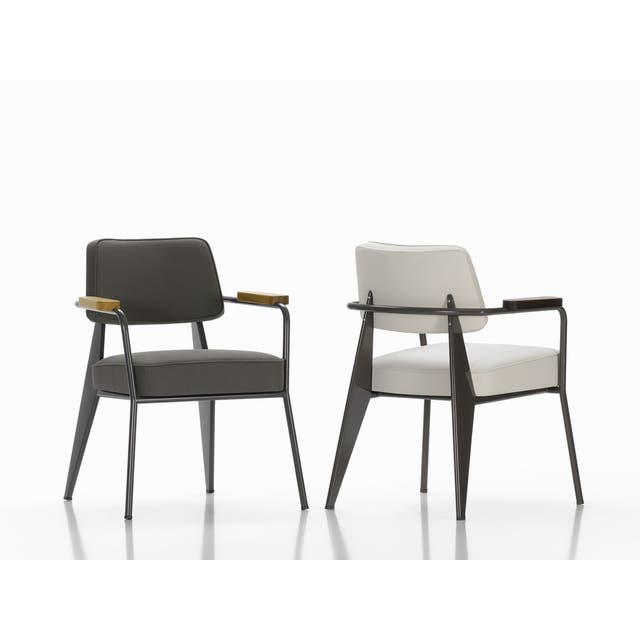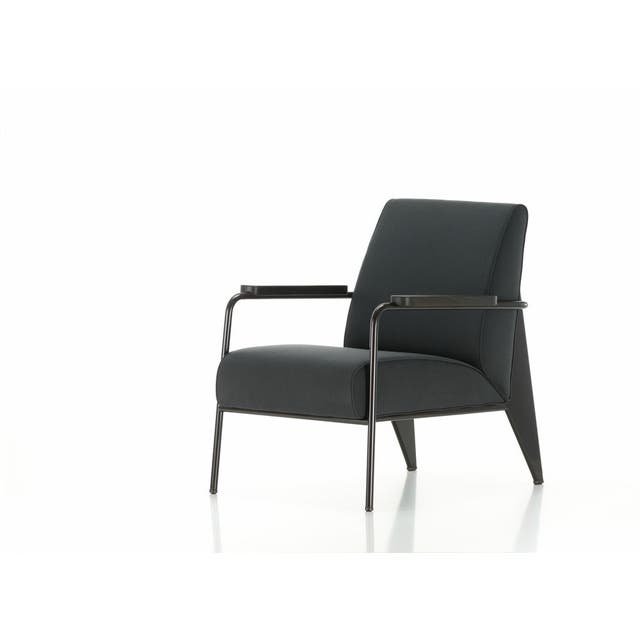Vitra Fauteuil Direction Pivotant Chair
The swivel seat of Fauteuil Direction Pivotant is height adjustable, and the backward tilt mechanism can be adapted to the individual user's weight. These features are paired with the generous upholstery to ensure optimum comfort. Leather or fabric covers are available in many different colours, making it easy to find the ideal chair for any type of business workplace or home office.
MEASUREMENTS:
- Height: 83.5 - 90 cm / 32.75 - 37.5 inch
- Width: 67 cm / 26.5 inch
- Depth: 55 cm / 21.5 inch
MATERIALS:
- Seat and backrest: polyurethane filling; cover in fabric or leather
- Armrests: solid wood with oiled finish; natural oak, smoked oak or American walnut
- Base: five-star base made of bent sheet steel and tubular steel, powder-coated (smooth)
HELPFUL NOTES:
- Seat mechanism: adjustable backward tilt, lockable in the forward position. Continuous seat height adjustment with gas spring

Jean Prouvé
France, 1901 - 1984
Jean Prouvé is one of the most influential furniture designers of the early modern design movement. Prouvé introduced industrial, engineered modern design aesthetic to interiors in the steel and aluminum furniture he created.
Jean Prouvé was born into an artistic family in Nancy, France; his famous father, Victor Prouvé, collaborated with the great Art Nouveau artists Emile Galle and Louis Majorelle. Prouvé was trained as a metal smith before attending engineering school in Nancy and his intimate knowledge of metal remained the foundation of his work and career. After opening his own workshop in 1923, he began producing modern metal furniture of his own design as well as collaborating with some of the best-known French modern designers of the day, including Le Corbusier and Charlotte Perriand. His shelving units for the dormitories at the Cite Internationale universitaire de Paris, designed with Perriand and the artist Sonia Delaunay in 1952, are perhaps the best-known examples of his collaborative work.
Jean Prouvé strove for the most efficient designs, with such classic results as the Standard Chair, 1934 and the Cite Chair of 1930. Utilizing his innovative method of folding sheet metal, Jean Prouvé designed a series of tables that have the perceived lightness of bridges and the presence of architecture. In the mid 1950s Jean Prouve began devoting his time to the challenges of prefabricated architecture. His own house, which he designed as a prototype, is now considered a major development in prefab housing.

Vitra is a Swiss company dedicated to improving the quality of homes, offices, and interior public spaces through the compelling power of design. Their chairs, tables, and accessories, including clocks, toolboxes, and cushions, are developed with an intensive, modern design process. Fusing engineering excellence with the creative genius of leading-edge international designers, Vitra enhances the aesthetic and emotional aspects of every space they grace.
All Vitra products are functional, inspiring, and durable. Founded in 1950, the family-owned Vitra line is designed and created by internationally recognized contemporary designers such as Verner Panton, Isamu Noguchi, Eero Saarinen, and Jasper Morrison. “We make products that avoid the superfluous and last for a very long time,” says Vitra chairman Rolf Fehlbaum.
This item qualifies for free door-to-door delivery within the Continental USA and Canada, with a few exceptions:
- Orders $180 or less are charged a $35 small order fee at checkout.
- Please contact us for a quote if you are located outside of the Continental USA.
- This is standard curbside delivery; meaning the driver will not haul up an incline or up stairs, and it will be your responsibility to bring the item inside, complete any assembly, and remove packaging debris.
- For a White Glove Delivery quote which includes unpackaging and assembly, please make a note in the Comments section during Checkout and we will get back to you as soon as possible.
For further information on our shipping policies click here.
For further information on returns + refunds click here.








